
Lent with Our Neighbours All Around the World
Lent with Our Neighbours All Around the World
We associate Lent with fasting and a time of reflection and prayer. This time is the most important time of the year, especially for the Catholics. It helps to prepare for the Easter.
Some countries have special festivities related to this time before Easter. Let’s see what the Lent celebrations look like in Europe and Mexico.
Lithuania Užgavėnės: Go Away Ugly Winter!
Užgavėnės is a festival that takes place the night before Ash Wednesday. This tradition resembles Mardi Gras and Carnaval. The main attraction of this holiday is the defeat of winter. The Lithuanians stage a battle between a fat porky figure symbolizing winter and the skinny hempen man personifying spring. Other characters such as the devil, witches, bears, goats, the Grim Reaper, and other jolly folks are part of the celebrations. People and the joyful figures dance wildly and celebrate this holiday before Lent. The traditional dishes are pancakes with different toppings, porridge, and meat dishes. To keep warm a lot of warm tea is served and there are a lot of bonfires everywhere to keep you warm.
Mexico: Be a Good Samaritan and Spread Some Good
On the fourth Friday of Lent, the Mexicans celebrate la Samaritana, Good Samaritan’s Day. It is a special day when free flavoured water such as horchata, jamaica and chilacayota, fruits, regional sweets and ice cream are given to people on the street to commemorate the Samaritan woman who gave Jesus water by the well. With this celebration, families show devotion and love to their neighbours. This tradition dates back to the 19th century when this initiative began thanks to the parish priests of San Francisco and la Merced in Oaxaca.
Luxembourg, Germany, France, and Belgium: Burn Old and Welcome the New
Buergbrennen is a celebration with an enormous bonfire that starts on the first Sunday of Lent. It is coming from the old tradition of burning old Christmas trees to end winter and welcome spring.
In Germany, some villages perform the reenactment of the Passion of Christ and organize processions. The Holy Thursday is called by Germans the Green Thursday. On this day Germans eat green food the whole day, mostly salad and spinach.
Denmark’s, Sweden’s, Norway’s, and Greenland’s Sweet Fastelavn
Fastelavn is celebrated in Northern Europe seven weeks before Easter Monday. On this day children and adults eat jam-filled pastries and wear costumes. Kids are trying to break open a cat barrel that contains candy. The first kid who breaks open the barrel, and is a boy, is called the Cat King. If this is a girl she is called the Cat Queen. Historically, there was a real cat in the barrel. People were chasing the cat meaning demolishing the evil and forcing it away.
Similarly to treat-or-treating, on this day children dress up and go door to door singing songs in the hope of getting some treats from the neighbours. It is also a great fun time for families to play games.
Vocabulary
Lent – in Christian religion an annual season of fasting and penitence in preparation for Easter beginning on Ash Wednesday and lasting 40 days to Easter (Wielki Post)
Fasting – abstain from all or some kinds of food and drink, especially as a religious observance (post)
Mardi Gras – the festival of Shove Tuesday celebrated in some cities with great revelry; Fat Tuesday (Tłusty Wtorek)
Hempen man – man of ordinary stature rather below than above and rather thinner than stout (tu: zwykły człowiek)
Grim Reaper – imaginary character symbolising death in the form of skeleton wearing a long black hooded cloak and caring a scythe (kostucha)
Jolly – happy and cheerful (wesoły)
Bonfire –a large open-air fire (ognisko)
Well – a deep hole full of water (studnia)
Devotion – religious worship or observance (tu: pobożność)
Barrel – a large wooden container with a flat top and bottom and curving sides that are wider in the middle (beczka)